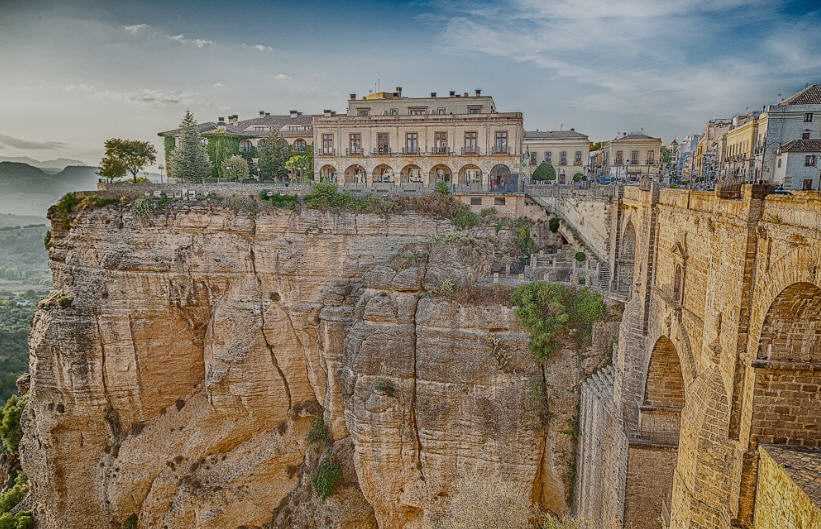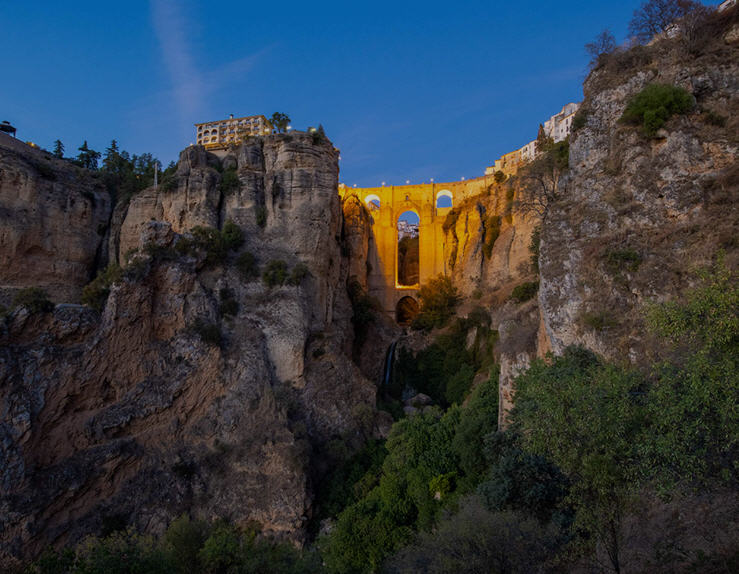
Blog:WGS-B0027
Country:Spain
City/Region: Ronda
Interest:Nature, History, Bridge
Best Time to Visit: April-May and September-October
Nearest Airport: Málaga Airport (AGP). From there, you can take a train, bus, or taxi to Ronda.
Table of Contents
Ronda bridge footsteps
Step onto the historic Puente Nuevo bridge in Ronda, its cobblestone paving worn smooth by centuries of footsteps. Hear the echoes of your own footfalls mingling with those of fellow travelers, creating a rhythmic chorus. Feel the gentle vibrations of the bridge underfoot, a subtle reminder of its age and strength. Pause at the railing and admire breathtaking views of the El Tajo gorge, your footsteps on the bridge becoming a part of Ronda’s enduring legacy.
Ronda hidden courtyards
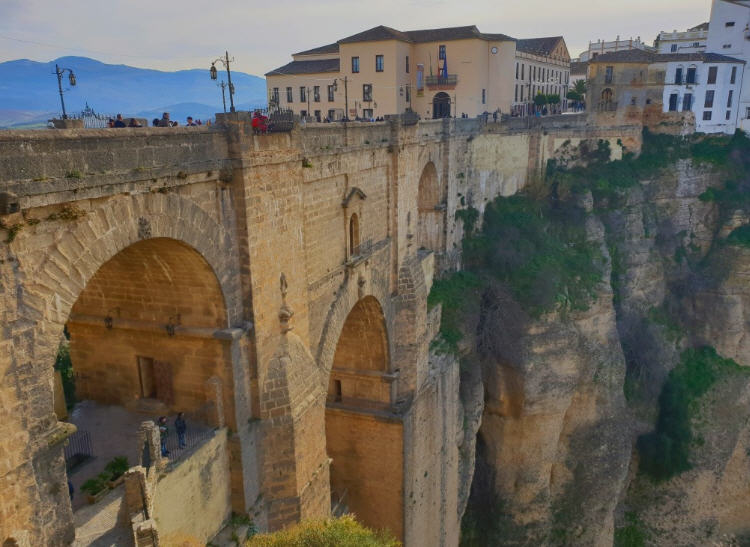
Escape the hustle and bustle of Ronda’s streets and discover its tranquil hidden courtyards. Venture through unassuming doorways into private havens adorned with vibrant flowers and the soothing sound of water fountains. Feel the cool shade cast by citrus trees and admire the intricate tilework that adorns the walls. Let the serenity and charm of these secluded spaces offer a moment of respite and a glimpse into the heart of traditional Ronda.
Ronda flamenco music
Step into the intimate world of a Ronda flamenco performance and be captivated by the raw energy and passion of this traditional art form. Hear the rhythmic pulse of the guitar, its soulful melodies setting the stage. Feel the intensity of the dancer’s footwork, their stomps echoing through the room in a percussive symphony. Listen to the emotional vocals of the cantaor, their voice filled with joy and lament. Immerse yourself in the rich tapestry of flamenco, where music, dance, and cultural heritage intertwine.
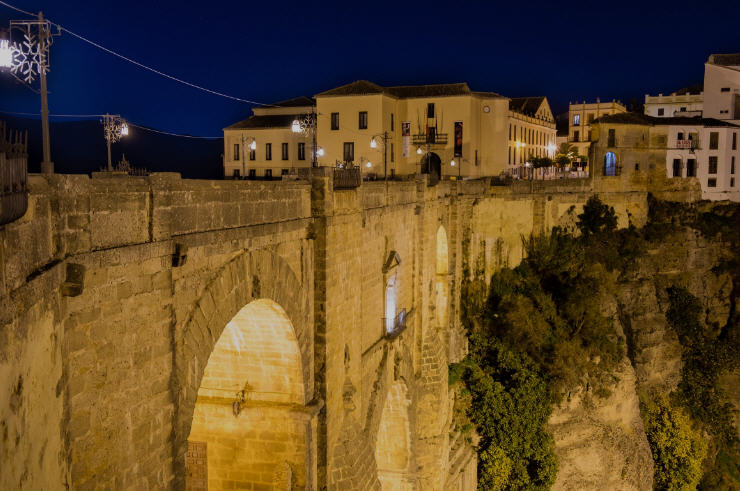
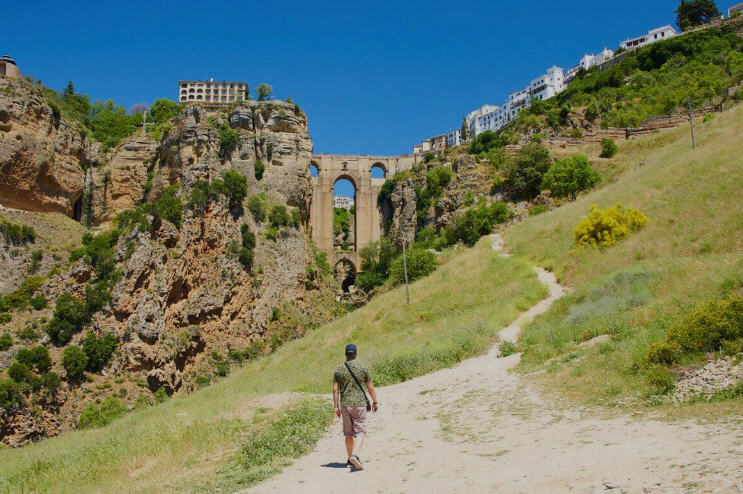
Ronda olive groves scents
Stroll through the ancient olive groves that blanket the hillsides surrounding Ronda. Breathe in the intoxicating aroma of sun-ripened olives, a sweet, earthy scent that fills the air. Crush an olive leaf between your fingers, releasing a pungent fragrance herbaceous and slightly bitter. Let the scent of olives evoke the essence of the Andalusian landscape and a sense of deep connection to the region’s agricultural heritage.
Ronda wind in the gorge
Stand high above Ronda’s El Tajo gorge and feel the relentless gusts of wind whipping through the canyon. Hear the howl of the wind as it forces its way through the narrow chasm, creating an almost mournful soundscape. Brace yourself against the force of the wind, a powerful reminder of nature’s raw energy. Witness the swirling patterns in the clouds overhead and the swaying of the trees below, a testament to the wind’s ever-present influence on the landscape.
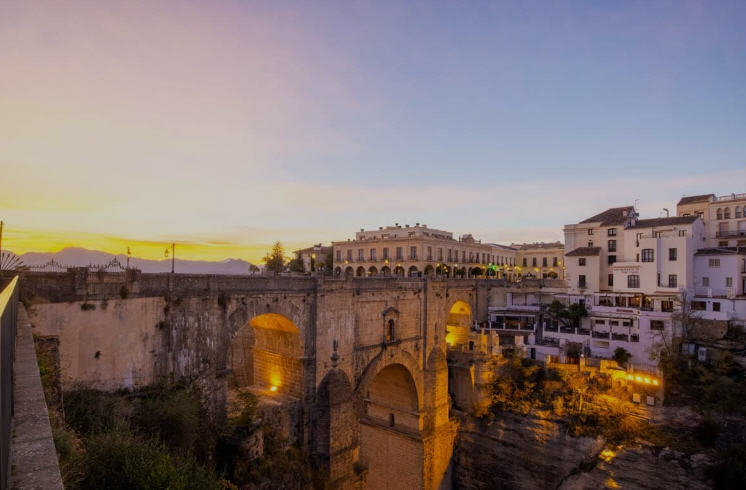
Ronda tapas crawl
Immerse yourself in the convivial atmosphere of a Ronda tapas crawl and embark on a culinary adventure. Savor a diverse array of delicious small plates, bursting with vibrant Andalusian flavors. From classic tortilla Española to sizzling gambas al ajillo (garlic shrimp), tantalize your taste buds with each new bite. Feel the buzz of lively tapas bars as you hop from one to the next, sharing food, laughter, and conversation with locals and fellow travelers alike. Discover the essence of Ronda’s social scene through its mouthwatering tapas.
Ronda bell tolls
Experience the timeless soundscape of Ronda, where the resonant chimes of church bells echo across the historic town. Hear the deep, melodious tolls from centuries-old bell towers, their sound carrying across cobblestone streets and charming plazas. At midday, let the joyous pealing of bells fill the air, announcing the passage of time. As dusk falls, the gentle ringing of distant bells creates a sense of tranquility. The bell tolls of Ronda become a soundtrack to your exploration, creating a captivating aural tapestry that reflects the town’s historical charm.
Ronda artisan workshops
Venture into the bustling world of Ronda’s artisan workshops. Hear the rhythmic hammering of a metalworker shaping a piece of iron, the satisfying tap-tap-tap echoing through the workshop. Feel the smooth, dry texture of handcrafted leather goods as you admire intricate designs. Observe the skilled hands of a potter molding clay on a spinning wheel, the rhythmic whirring and the gentle squish creating a mesmerizing spectacle. Immerse yourself in the creative energy of Ronda’s workshops, where centuries-old traditions live on through the sights, sounds, and textures of traditional craftsmanship.
Things to Do
Different Interest:
- Adventurers: Hike the scenic El Tajo gorge, descend into the depths of the Cueva de la Pileta with its prehistoric paintings, or try white-water rafting on the Guadalevín River.
- History Buffs: Explore the Ronda Archaeological Museum, visit the Palacio de Mondragón for a glimpse into noble life, or delve into the fascinating history of bullfighting at the Plaza de Toros.
- Nature Lovers: Stroll through the Alameda del Tajo, a verdant walkway offering panoramic views of the gorge, or take a picnic to the serene Jardines de Cuenca.
- Foodies: Savor the delights of Andalusian cuisine at local tapas bars, try the unique Ronda “molletes” bread, or indulge in fresh seafood at a riverside restaurant.
Exploring Beyond Ronda:
- Setenil de las Bodegas: This whitewashed village, nestled within the cliffs, is a photographer’s paradise with houses built directly into the rock face.
- El Caminito del Rey: For the truly adventurous, embark on this thrilling hike along a narrow gorge pathway suspended high above the Guadalevín River.
- The Pueblos Blancos: Discover the charm of the “White Villages” scattered across the Andalusian countryside, each with its own unique character and charm.
Nearest Airport and Best Time to Visit
Getting There:
The nearest airport is Málaga Airport (AGP) located approximately 100 kilometers from Ronda. Several public buses and train options connect the airport to Ronda, making it easily accessible.
Best Time to Visit:
The best time to visit Ronda is during the spring (April-May) and autumn (September-October) when the weather is pleasant and the crowds are smaller. You can also enjoy the city during the summer (June-August) but be prepared for hot temperatures.
Want to get in touch with us?
Questions you might have for this Blog
Feel free to ask questions.
General Questions:
If you have noticed any information that is not accurate, please let us know.
An Advertiser:
Your ads will be in the section below “Ads for Businesses”. Please also refer to the Subscription Plans tab.
For ads we would prefer your website presence where you would maintain your B2B price, deals or promotions etc. A control number link will connect to advertisers website.
Book Air and Hotel (Check for deals in our Ad Section below)

Travel Insurance

- InsureMyTrip : (https://www.insuremytrip.com/) This is a well-known online platform that allows users to compare and purchase travel insurance from various providers.
- TravelGuard https://www.travelguard.com/) TravelGuard is a reputable company that offers comprehensive travel insurance plans and is often cited as a reliable source for purchasing travel insurance.
- Squaremouth https://www.squaremouth.com/) Squaremouth is an authoritative website for comparing travel insurance policies and obtaining quotes from different providers, making it a valuable resource for travelers seeking coverage.
Business Ad Section - This may include deals or promotions.
Ronda History
Ancient Foundations
- Celtic Origins: The earliest known settlement dates back to the 6th century BC, with Celtic tribes founding the town initially named Arunda.
- Roman Rule: Romans conquered it by the 2nd century BC, renaming it Laurus and shaping its infrastructure with roads and buildings.
- Visigoth Era: After the Roman Empire’s decline, Visigoths held sway for a period.
Islamic Period: A Flourishing City
- Moorish Conquest (713 AD): Ronda fell under Islamic rule, becoming “Izn-Rand Onda,” a fortified and strategically significant city within Al-Andalus.
- Growth and Importance: It was the capital of its own taifa (kingdom) for a time, and developed a thriving economy, distinctive architecture, and cultural life.
- Remaining Legacy: Parts of the Arab Baths, the city walls, and the Alminar of San Sebastián reflect this era.
Reconquista and Christian Transformation
- Castilian Siege (1485): A lengthy and difficult siege by Christian forces eventually led to Ronda’s fall, a major symbol during the Reconquista.
- New Order: Like much of Andalusia, Ronda saw the expulsion or forced conversion of Muslims and Jews, the building of Catholic churches, and the imposition of Spanish rule.
- Bandit Country (18th-19th centuries): The area’s rugged terrain became a haven for bandits and smugglers, contributing to Ronda’s romantic and sometimes rebellious image.
Modern Era: Tourism and Development
- Inspiration for Artists: 19th-century travelers and artists like Washington Irving and Ernest Hemingway were drawn by Ronda’s dramatic setting and history, spreading its fame.
- Bullfighting Tradition: Ronda is considered a birthplace of modern bullfighting, with its iconic Plaza de Toros built in the 1780s.
- Tourism Boom (20th Century Onwards): Ronda’s well-preserved historic center, the Puente Nuevo, and stunning landscapes made it a major tourist draw, reshaping the town’s economy.
Key Points
- Ronda’s location on a naturally defended plateau shaped its history as a stronghold contested by different powers.
- Its layered past is visible in the blend of Roman, Islamic, and later Spanish architecture.
- Ronda’s romantic image was both fueled by artists and writers and by its real history of resistance and rebellion.
Resources for Exploration
- Andalucia.com – Ronda History: https://www.andalucia.com/ronda/history.htm
Some interesting facts
Yes! Ronda is a city in the province of Málaga in the autonomous community of Andalusia. It is known for its picturesque location on a mountain plateau. Its historic old town and impressive bridge over the El Tajo gorge are very popular attractions.
The landscape, the layout of the town, its history, the romantic legend of its bandits with their evocative names, the cradle of bullfighters and artists whose names have gone down in history: all this makes Ronda a unique city.
- Ronda Bullring. Starting point: Bullring.
- New Bridge. Ronda.
- Arab baths in Ronda. Moorish King’s Palace and Arab Baths.
- Church of Santa María la Mayor in Ronda. A stroll through the historic quarter.
- Alameda del Tajo viewing point. Ronda.
- Ronda landscape. Other activities in Ronda.
A two-day trip to Ronda will enable you to take in all it has to offer, from the dramatic El Tajo gorge to one of Spain’s most historic and beautiful bullrings. Read on for our guide to spending 48 hours in this enchanting Andalusian town.
The footpath leading down to the gorge starts just to the side of Plaza de Maria Auxiliadora, leading away from the old town. The stone covered track is easy to follow and it’s possible to take a pushchair or wheelchair all the way to the bottom.
Ronda is known for its cliffside location and a deep canyon that carries the Guadalevín River and divides the town. It is one of the towns and villages that are included in the Sierra de las Nieves National Park.
